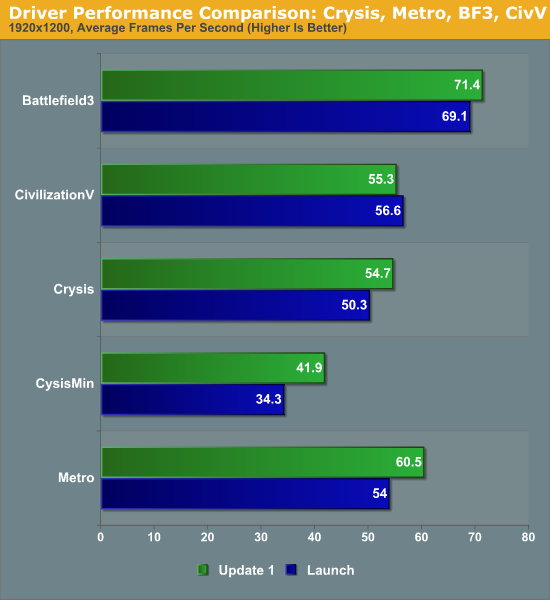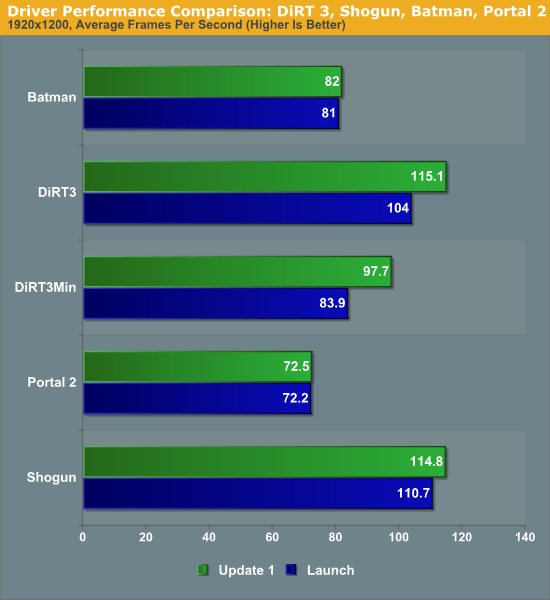AMD Radeon HD 7950 Review Feat. Sapphire & XFX: Sewing Up The High-End Market
by Ryan Smith on January 31, 2012 9:02 AM ESTGetting the Most Out of GCN: Driver Improvements
With the launch of any new architecture there’s still a lot of room for improvement on the part of driver developers, and GCN is no exception. On January 20th AMD released the first driver update for the 7000 Series, which brought with it an interesting mix of bug fixes, new features, and performance improvements. On the feature side AMD enabled support for Analytical Anti-Aliasing and Super Sample Anti-Aliasing for DX10+ games, an overdue feature that we’re very happy to see finally make it to AMD cards. Meanwhile on the performance side the new drivers improved the performance of the 7000 series in several games. Game performance typically rises slowly over time, but as this is one of the first post-launch driver releases, the gains are larger than what we’re used to seeing farther down the line.
To get an idea of where performance has improved and by how much, we reran our entire benchmark suite on the 7970.


As to be expected, at this point in time AMD is mostly focusing on improving performance on a game-by-game basis to deal with games that didn’t immediately adapt to the GCN architecture well, while the fact that they seem to be targeting common benchmarks first is likely intentional. Crysis: Warhead is the biggest winner here as minimum framerates in particular are greatly improved; we’re seeing a 22% improvement at 1920, while at 2560 there’s still an 11% improvement. Metro:2033 and DiRT 3 also picked up 10% or more in performance versus the release drivers, while Battlefield 3 has seen a much smaller 2%-3% improvement. Everything else in our suite is virtually unchanged, as it looks like AMD has not targeted any of those games at this time.
As one would expect, a result of these improvements the performance lead of the 7970 versus the GTX 580 has widened. The average lead for the 7970 is now 19% at 1920 and 26% at 2560, with the lead approaching 40% in games like Metro that specifically benefited from this update. At this point the only game the 7970 still seems to have trouble pulling well ahead of the GTX 580 is Battlefield 3, where the lead is only 8%.










259 Comments
View All Comments
xeridea - Tuesday, January 31, 2012 - link
Tru Datxeridea - Tuesday, January 31, 2012 - link
But not as bad as the Obamination we are in today.bji - Tuesday, January 31, 2012 - link
Which is better than the Bush clusterf** we were in yesterday ...Sabresiberian - Tuesday, January 31, 2012 - link
Too bad we can't actually blame stupidity on some drug that we can prevent people from smoking.;)
dagamer34 - Tuesday, January 31, 2012 - link
So you want to wag your finger at AMD for trying to make money when Nvidia has decided not to show up for a few months? Everyone knows that competition drives lower prices and right now AMD doesn't have any at the truly high end. If you want the parts now, you can pay up or wait. It's that simple.I am actually glad AMD is competing at the truly high end again because it shows confidence in their products. Confident products = bolder designs in the long term.
chizow - Tuesday, January 31, 2012 - link
Actually I've been saying for years AMD missed an opportunity to profit by mispricing their RV770 badly. Ever since that time they've been trying to dig themselves out of the pricing mistake they caused, because as a direct result, Nvidia dropped their flagship single-GPU prices to $350-400 for the 2nd tier and $500 for the top single gpu. Since AMD's subsequent parts have always trailed Nvidia's same-gen parts, they were obviously forced to price their cards according to Nvidia's performance, which generally meant $400 or less.The problem is that SI offers none of the performance and value you would expect from a next-gen part, nor does it raise the bar for price/performance. It only manages to keep the status quo using last-gen metrics and the 7950 is direct proof of this. Its roughly the same price and performance as the GTX 580, which would've been great if this were 2010 when the GTX 580 launched, but its 2012 now.
arjuna1 - Tuesday, January 31, 2012 - link
leave it to an nvidia fanboy to twist facts around as needed to put nvidia on top.chizow - Tuesday, January 31, 2012 - link
I didn't say Nvidia was on top...But honestly, as an ATI fan take a look at the 6970 results compared to the 7950 and then ask yourself if you really think the 7950 is worth the price at $450-500 compared to the $300-350 for a 6970....
I mean if you thought the 6970 was a great deal compared to the GTX 580 how on earth could you think the 7950 is some amazing bargain some 14 months later?
Galidou - Tuesday, January 31, 2012 - link
OMG and you just realized that? Welcome in 2012, you hav ebeen sleeping for the last 20 years?!?Video card manufacturers have done that a thousand times before... Nvidia and Ati with their rebranding and next gen higher priced than last gen for the same performance... The top segment was never meant to be performance/price top of the chart.... OMG.
So by listening to what you said from the beginning, anything below gtx 580 is useless, because you can find last gen video card lower priced for more or same performance, because of the next-gen price premium... HELLO!?! wake up...
You can find gtx 480's at a way lower price than gtx 570's on the bay for about the same performance...
You can find radeon 4870 about half the price of 6770's for about the same performance....
And so on....
chizow - Tuesday, January 31, 2012 - link
I don't think you understand that in your attempt to discredit my point, you've actually completely validated it.Yes, historically when a new part releases it compresses prices and forces older last-gen parts to drop in price as the new price:performance metrics dictate a drop in price with the next-gen level of performance.
None of this is occurring with SI because AMD has priced this part exactly where its performance lies because they are basing this on last-gen metrics. If anything, lower tier parts are probably UNDER priced relative to performance compared to SI and have no reason to drop in price.